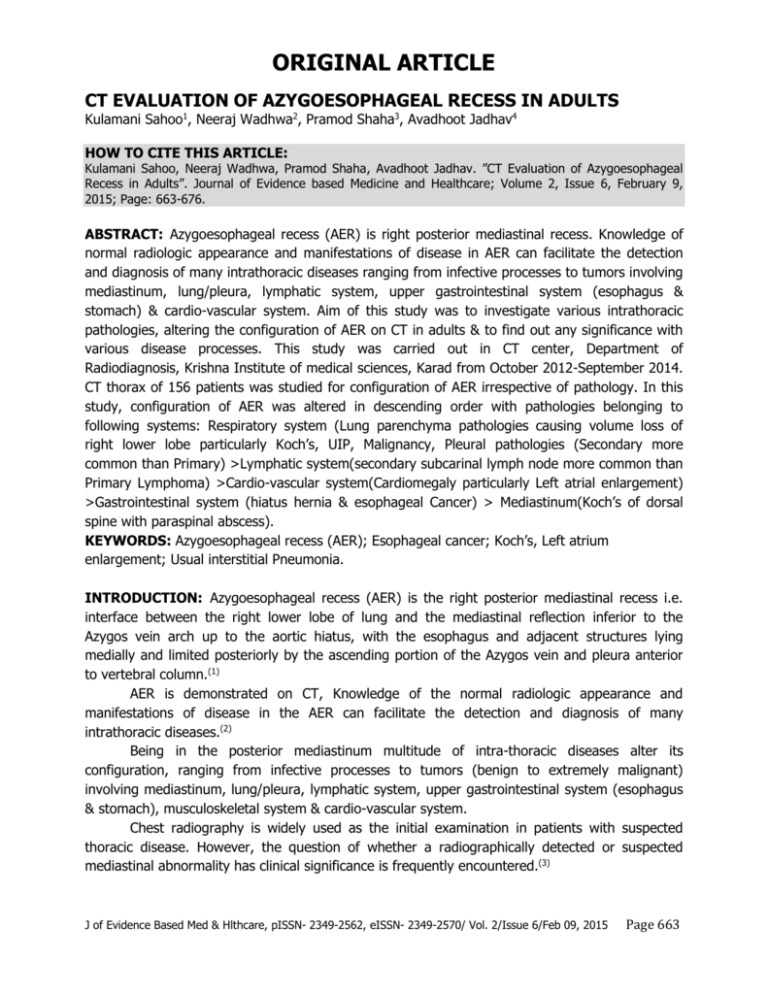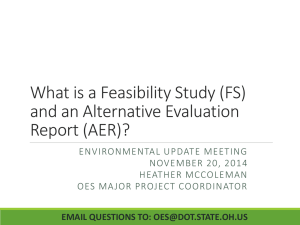ct evaluation of azygoesophageal recess in adults
advertisement

ORIGINAL ARTICLE CT EVALUATION OF AZYGOESOPHAGEAL RECESS IN ADULTS Kulamani Sahoo1, Neeraj Wadhwa2, Pramod Shaha3, Avadhoot Jadhav4 HOW TO CITE THIS ARTICLE: Kulamani Sahoo, Neeraj Wadhwa, Pramod Shaha, Avadhoot Jadhav. ”CT Evaluation of Azygoesophageal Recess in Adults”. Journal of Evidence based Medicine and Healthcare; Volume 2, Issue 6, February 9, 2015; Page: 663-676. ABSTRACT: Azygoesophageal recess (AER) is right posterior mediastinal recess. Knowledge of normal radiologic appearance and manifestations of disease in AER can facilitate the detection and diagnosis of many intrathoracic diseases ranging from infective processes to tumors involving mediastinum, lung/pleura, lymphatic system, upper gastrointestinal system (esophagus & stomach) & cardio-vascular system. Aim of this study was to investigate various intrathoracic pathologies, altering the configuration of AER on CT in adults & to find out any significance with various disease processes. This study was carried out in CT center, Department of Radiodiagnosis, Krishna Institute of medical sciences, Karad from October 2012-September 2014. CT thorax of 156 patients was studied for configuration of AER irrespective of pathology. In this study, configuration of AER was altered in descending order with pathologies belonging to following systems: Respiratory system (Lung parenchyma pathologies causing volume loss of right lower lobe particularly Koch’s, UIP, Malignancy, Pleural pathologies (Secondary more common than Primary) >Lymphatic system(secondary subcarinal lymph node more common than Primary Lymphoma) >Cardio-vascular system(Cardiomegaly particularly Left atrial enlargement) >Gastrointestinal system (hiatus hernia & esophageal Cancer) > Mediastinum(Koch’s of dorsal spine with paraspinal abscess). KEYWORDS: Azygoesophageal recess (AER); Esophageal cancer; Koch’s, Left atrium enlargement; Usual interstitial Pneumonia. INTRODUCTION: Azygoesophageal recess (AER) is the right posterior mediastinal recess i.e. interface between the right lower lobe of lung and the mediastinal reflection inferior to the Azygos vein arch up to the aortic hiatus, with the esophagus and adjacent structures lying medially and limited posteriorly by the ascending portion of the Azygos vein and pleura anterior to vertebral column.(1) AER is demonstrated on CT, Knowledge of the normal radiologic appearance and manifestations of disease in the AER can facilitate the detection and diagnosis of many intrathoracic diseases.(2) Being in the posterior mediastinum multitude of intra-thoracic diseases alter its configuration, ranging from infective processes to tumors (benign to extremely malignant) involving mediastinum, lung/pleura, lymphatic system, upper gastrointestinal system (esophagus & stomach), musculoskeletal system & cardio-vascular system. Chest radiography is widely used as the initial examination in patients with suspected thoracic disease. However, the question of whether a radiographically detected or suspected mediastinal abnormality has clinical significance is frequently encountered.(3) J of Evidence Based Med & Hlthcare, pISSN- 2349-2562, eISSN- 2349-2570/ Vol. 2/Issue 6/Feb 09, 2015 Page 663 ORIGINAL ARTICLE Radiographically abnormal AER is manifested as any convexity directed to right, abnormal opacity in AER or non-visualization of right main stem bronchus/ bronchus intermedius.(2) However it may not be possible to detect all lesions affecting AER on radiography, this fact can be postulated to previous studies in literature: a) Lindell MM et al, 1979,(4) in a retrospective study of 103 Esophageal cancer with 79 cancer of middle/ distal third only 20 had abnormality of AER. b) Muller NL et al, 1985,(5) in its study on subcarinal lymph node enlargement postulated that AER can appear radiographically normal even when subcarinal adenopathy greater than 1.5 cm is present. Computed tomography (CT) may demonstrate masses not recognized on conventional radiologic examinations and may provide unique and specific diagnostic information relative to chest film in about half of times.(6) There is paucity of literature on study of AER by Computed tomography & its correlation with various pathologies for any Significance& much has been concentrated only on enumerating possible pathologies altering the configuration on CT. Changes in shape of AER may possibly facilitate in detecting disease activity/stage of disease. Aim of the study is to investigate various mediastinal and intrathoracic pathologies, altering the configuration of AER on CT in adults &to find out any significance between alterations of AER configuration with different pathologies. MATERIALS AND METHODS: Observational study carried out from October 2012 - September 2014 in Department of Radiodiagnosis, KIMS, Karad. A total of 156 patients with clinical indications for imaging of CT thorax, were studied for configuration of AER. Patients less than 19 years of age, Allergic to contrast media, not able to suspend breathing in inspiration, or those with h/o surgery, post treatment (post -chemotherapy, postradiotherapy etc) were excluded from study. EQUIPMENT: 16 slice MDCT Siemens Emotion held within suitable environment held in Department of Radiodiagnosis, KIMS, Karad was used for conducting the study. CT TECHNIQUE: Sections were taken using 130 KV and 70m As, slice thickness ~ 5 mm, with retro-collimation of ~ 0.6/1.2 mm. Images were obtained with patient suspended breathing in maximum inspiration/ intermittent suspended inspiration, in both lung (B 70 s) & soft tissue kernels (B 30 s) from the level of lung apices to the diaphragm and routinely including the adrenals. Post-contrast study was done whenever advised using 100 ml of non –ionic iodinated contrast containing 37 gms of iodine; injected via antecubital vein at rate of 2-3 ml/ sec using pressure injector. Pre and post contrast attenuation values, the size, location of the lesion, presence of calcification, mass effect on adjoining structures and others associated findings were studied. J of Evidence Based Med & Hlthcare, pISSN- 2349-2562, eISSN- 2349-2570/ Vol. 2/Issue 6/Feb 09, 2015 Page 664 ORIGINAL ARTICLE EVALUATION CRITERIA: Shape of Normal AER is Dextroconcave/ convex towards the left or had an approximately straight left wall.(7,8) Disturbed normal configuration of AER which is normally a smooth arc concave to the right anywhere along the length of AER-azygos arch superiorly to aortic hiatus inferiorly.(9) Radiologically typically manifests as altered contour and or density. Minimal Size of mediastinum lymph node (subcarinal & Para-esophageal lymph node) in its short axis altering the configuration of Azygoesophageal recess was calculated. Minimal abnormal thickness of esophagus altering the configuration of AER was calculated. Chest size dimensions (Antero-posterior & transverse) were calculated at the level of carina& were compared with shape of recess. OBSERVATION AND RESULTS: AGE WISE DISTRIBUTION OF CASES: Descending Order: More than 60 yrs (41%) > 40 – 60 yrs (32 %) > 19-40 yrs (27 %) 73 % of cases belonging to above 40 yrs of age. GENDER WISE DISTRIBUTION OF CASES: Male patients ~ 66 %, Female patients ~ 44 %, Approximate ratio – (M: F); (1.5:1) Graph 1: % distribution of cases according to system *-27 cases were common to both Respiratory system & lymphatic system as cases with secondary lymph node enlargement were secondary to pathology in respiratory system. ** – Mediastinum includes anterior & posterior mediastinum but excluding pathologies involving heart, vascular system, upper gastrointestinal system & lymphatic system. J of Evidence Based Med & Hlthcare, pISSN- 2349-2562, eISSN- 2349-2570/ Vol. 2/Issue 6/Feb 09, 2015 Page 665 ORIGINAL ARTICLE RESPIRATORY SYSTEM: Includes pathologies involving Lung parenchyma & Pleura. Approx~ 50 % of cases (77/156) were observed involving Respiratory system (lung parenchyma & or pleura), out of which approx ~ 24 % (36/77) were seen altering the configuration of AER. Graph 2: distribution of cases within respiratory system Isolated Lung parenchymal involvement affecting AER was observed in 9 cases corresponding to 12 % out of 77 cases. Similarly isolated pleural involvement was observed in 2 cases, corresponding to 2.5 %, both of which affected AER. Combined involvement [Cases with pleural & lung involvement +/- Lymph node involvement] affecting AER was observed in 32.5 % out of 77cases. AGE/GENDER DISTRIBUTION OF PATHOLOGY WITHIN RESPIRATORY SYSTEM: A) Consolidation–predominantly involving young age group 19 – 40 yrs; M: F, 1: 1. B) Tumor/volume loss–predominantly involving Older age group >60 yrs; M: F. 2: 1. PLEURAL INVOLVMENT: Includes primary & secondary Pleural pathologies. Combined involvement [Cases with pleural & lung involvement +/- Lymph node involvement] affecting AER was observed in 23.4 % out of 77 cases. CAUSE/AGE/GENDER – DISTRIBUTION OF PLEURA PATHOLOGY AFFECTING AER: Predominantly involving younger age group 40 – 60 years; M: F,2: 1 MEDIASTINUM: Includes pathologies involving Anterior & posterior mediastinum excluding heart, vascular system, lymphatic system, gastrointestinal system involvement. A total of (14/156) cases corresponding to 06 % were observed affecting mediastinum, out of which 5 cases (35.7 %) out of 14 caused dextroconvexity of AER. DISTRIBUTION WITHIN MEDIASTINUM: In posterior mediastinum 4 cases out of 12 corresponding to 21.1 % out of 14 affected AER. J of Evidence Based Med & Hlthcare, pISSN- 2349-2562, eISSN- 2349-2570/ Vol. 2/Issue 6/Feb 09, 2015 Page 666 ORIGINAL ARTICLE In anterior mediastinum only single case out of 2 corresponding to 5.3 % out of 14 indirectly affected AER. AGE/GENDER DISTRIBUTION OF MEDIASTINUM PATHOLOGY AFFECTING AER: Posterior Mediastinum–predominantly involving 40-60 years; M:F,3:1 Anterior Mediastinum–predominantly involving 40-60 years; M:F,1:0 LYMPHATIC SYSTEM: Includes primary & secondary Lymphatic involvement. Primary lymphatic was observed affecting AER in 4 cases corresponding to 12.9 % out of 31 cases. Similarly Secondary lymphatic involvement was observed affecting AER in 11 cases corresponding to 33.3 % out of 31 cases. Age/ Gender Distribution Of Lymphatic System Pathology Affecting AER. Predominantly involving Older age group > 60 years; M: F, 2.5: 1. LOCATION OF LYMPH NODE WITHIN MEDIASTINUM FOR SECONDARY LYMPHATIC SYSTEM INVOLVMENT: Mainly it was subcarinal Lymph node -10 cases corresponding to 30 %, paraesophageal lymph node in single case corresponding to 3 % caused dextroconvexity of AER, while lymph node at other location did not affected AER. Graph 3: Cause distribution of secondary lymphatic pathology cases affecting aer GASTROINTESTINAL SYSTEM: Includes upper gastrointestinal system –esophagus & stomach. CAUSE DISTRIBUTION OF PATHOLOGY AFFECTING AER: Esophageal cancer of distal third 33 % (5/15) altered the configuration of AER. Hernia in 40 % including 5 cases of hiatus hernia & single case of Bochdalek hernia affected AER. J of Evidence Based Med & Hlthcare, pISSN- 2349-2562, eISSN- 2349-2570/ Vol. 2/Issue 6/Feb 09, 2015 Page 667 ORIGINAL ARTICLE AGE/GENDER DISTRIBUTION OF PATHOLOGY AFFECTING AER: Predominantly involving older age group - > 60 years; (M:F), (2.5: 1). CARDIOVASCULAR (CVS) SYSTEM: Includes heart & vascular system. Cardiovascular involvement was observed in 15 % (23/156) of total cases, out of which 56.5 % (13/23) altered the configuration of AER. Graph 4: Cause distribution of cases affecting aer within cardiovascular system AGE/GENDER DISTRIBUTION OF CARDIOVASCULAR PATHOLOGY AFFECTING AER: Predominantly involving Older age group > 60 years of age; M:F,3:1 DISCUSSION: Multitudes of pathologies belonging to various systems alter the configuration of AER. Pathology was encountered in a total of 135 cases which was further divided into various systems involving it such as respiratory system, mediastinum, lymphatic system,gastrointestinal system &cardiovascular system. In this study no pathology was observed in 21 out of which 19 have dextroconcave contour of AER or had an approximately straight left wall, rest 2 have dextroconvex contour of Azygoesophageal recess, which is in agreement with a study conducted by Onitsuka H et al, 1980(10) in which dextroconvexity on chest CT scans has been reported as a normal variant in 7% - 21% of cases, principally at the level of the carina and Azygos arch because of the Azygos vein draining into Superior vena cava. The AER reflection is a prevertebral structure and is therefore, disrupted by prevertebral disease. It has an interface with the middle mediastinum; thus, the configuration of recess can be interrupted by abnormalities in both the middle and posterior compartments.(11) J of Evidence Based Med & Hlthcare, pISSN- 2349-2562, eISSN- 2349-2570/ Vol. 2/Issue 6/Feb 09, 2015 Page 668 ORIGINAL ARTICLE Respiratory system: Most common pathologies altering the contour of AER were those causing atelectasis/ volume loss of right lower lobe i.e. tumor, interstitial lung disease &chronic infective etiology of right lower lobe. Tumor/Collapse of right lower lobe were observed affecting AER in 38 % cases (14/36).Volume loss was seen affecting AER in 36% cases (13/36).Consolidation-Isolated consolidation did not affect the AER. Consolidation with associated findings such as pleural effusion or subcarinal lymph node enlargement affected AER in 26% cases (09/36). In this series neoplastic etiology (primary> metastasis) followed by endobronchial tuberculosis of right lower lobe caused dextroconvexity of AER. Malignant Neoplastic etiologies in 28% cases (8/14) were FNAC proven, however others could not be followed up. Endobronchial tuberculosis was given in 2 cases as differential diagnosis with neoplastic etiology; but no definitive follow up is available for that. Two cases with metastasis to right lower affected AER, one from primary being Carcinoma Ovary & another being from Squamous cell Carcinoma of skin. In volume loss, most common cause was Bronchiectasis particularly of right lower lobe (7/13~ 54%), altered contour of AER secondary to chronic infective etiology such as Koch’s, followed by Interstitial Pneumonias (6/13~ 46%) (UIP >IPF> NSIP) as fibrosis is more evident in the former than latter and so is volume loss, particularly of lower lobes. Among the infective cases all had h/o tuberculosis except one which was given as probable chronic infective etiology. Rest were given as probable interstitial lung disease, however no definitive FNAC/biopsy report are available except two who were known case of rheumatoid disease with secondary UIP within lung parenchyma. In this study age & sex distribution pattern of probable Interstitial lung disease (ILD) correlated with study done by Emma C. Ferguson et al, 2012(12)on Lung CT- Interstitial pneumonia, in which she compared clinical, pathological & CT manifestations of ILD, however we could not find any study regarding comparison of various pathologies altering the configuration of AER. 2 cases of Primary Pleural pathology – Firstly single cases of Isolated Pleural Mesothelioma with another cases having unexplained pleural effusion on right side altering the contour of AER were observed. Secondary Pleural pathologies (effusion/ thickening/ calcification) were usually secondary to lung parenchyma pathology. Out of cases that did not affect AER-61 % cases (47/ 77) were having combined pathology i.e. (both lung & pleural) but did not affect AER (did not cause collapse of right lung, either they had unilateral left lung involvement or had only upper lobe involvement). Mediastinum: A total of (14/156) cases corresponding to 06 % were observed, out of which 5 caused dextroconvexity of AER. Posterior mediastinum–14.29 % (2/14) cases of Koch are involving the dorsal spine with paraspinal abscess, caused dextroconvexity of AER. In 50%(07/14) cases, anterior osteophytes from peridiscal margins of dorsal vertebra was observed, however AER was altered in only one case given as probable DISH. Only 21.43% (3/14) cases of posterior mediastinum Neurogenic Tumor (all FNAC proven) were encountered but they did not alter the AER as they were on the left side. J of Evidence Based Med & Hlthcare, pISSN- 2349-2562, eISSN- 2349-2570/ Vol. 2/Issue 6/Feb 09, 2015 Page 669 ORIGINAL ARTICLE Anterior mediastinum-Single case of large Germ cell tumor (FNAC proven- Seminomatous Germ cell tumor) involving the anterior mediastinum was seen displacing heart & other mediastinum structures posteriorly & thus indirectly altering AER. To our knowledge no comparative study was found in literature with reference to mediastinum mass affecting AERon CT. Lymphatic system involvement: Primary Lymphatic system:In this study primary lymphoma affected AER in 66.67% (4/6) cases. Secondary Lymph Node Enlargement: In the present study, it was subcarinal & right paraesophageal lymph node that altered configuration of AER. Lymph node did not affect AER when it was <1 cm in short axis or when it was present anterior to the recess in subcarinal space. We find subcarinal lymph node enlargement as the most common abnormality in the superior aspect of recess altering the contour of recess. Common causes of Subcarinal LN enlargement in descending order were as bronchogenic carcinoma (5) >Infective etiology (4) >metastasis (1) which were fairly consistent with studies done by James G R et al,2002(2) & Muller NL et al 1985.(5) For enlarged Paraesophageal lymph node we observed only 1 case in patient with Esophageal Cancer, measuring >1 cm in short axis dimension, causing dextroconvexity of AER. Gastrointestinal system: In this series, suspected cases of upper abdominal pain/ dysphagia/ vomiting were taken up for evaluation of upper gastrointestinal system. For esophageal cancer of distal third, we observed minimal esophageal thickening of 6-7 mm (either an eccentric nodular thickening affecting right lateral wall or asymmetric circumferential thickening) causing dextroconvexity of AER corresponding to stage II or above. However no study in literature was found on Oesophageal Cancer staging with CT correlation with relation to AER. Similarity Hiatus hernia in equal numbers as esophageal cancer caused dextroconvexity of AER in the inferior aspect. These findings were consistent with study done by James et al in 2002(2) in which hiatus hernia was mentioned as most common abnormality in the inferior aspect of AER. CARDIOVASCULAR SYSTEM: Most common etiology was isolated left Atrium enlargement 17.3% (04cases) that caused dextroconvexity of AER followed by Generalized cardiomegaly with pericardial effusion 13 %(03 cases); then Generalized cardiomegaly without pericardial effusion 9% (02 cases); lastly Aortic anomaly 9 % (02 cases) & Periesophageal collaterals (02 cases). Congestive heart failure was seen in a single case in which dilated IVC caused dextroconvexity of AER. Aortic pathology in 2 cases i.e. a single case of thrombosed aneurysm & in another case where the aorta was pushed to the right of vertebra by hiatus hernia containing fundus of stomach. To our knowledge no correlative study could be found. J of Evidence Based Med & Hlthcare, pISSN- 2349-2562, eISSN- 2349-2570/ Vol. 2/Issue 6/Feb 09, 2015 Page 670 ORIGINAL ARTICLE LIMITATIONS OF THE STUDY: The principal limitation of this study is that post treatment imaging was not done in follow up to correlate imaging findings with treatment efficacy. Lastly this is an observational study with a relative small series & there is deficiency of data in literature so it lacks correlation with other studies. CONCLUSION: This study reviews the variety of the disease processes involving the various systems altering the configuration of AER. Within respiratory system, it was Collapse/ Volume loss of lung parenchyma particularly of right lower lobe that altered the configuration of AER secondary to chronic infective, Neoplastic lesion or Interstitial lung disease followed by Secondary Pleural pathologies & rarely by primary pleural pathology. For mediastinum it was Lymphoma, Subcarinal Lymph node as most common pathologies causing dextroconvexity of superior aspect of AER. Hiatus hernia, distal third esophageal cancer [corresponding to stage II and above] causing dextroconvexity of inferior aspect of AER & Cardiomegaly particularly left atrial enlargement among others. Finally we can conclude that various disease process alter the configuration of AER, which may be taken as an additional observation in detecting abnormality though non-specific in diagnosing diseases, however due to relatively small sample size & no post treatment follow up in this series, more experience shall be needed to establish the accuracy of CT imaging in correlating various pathologies with alteration of AER configuration which may be used in monitoring treatment efficacy. Fig. 1: Coronal CECT Reformat – Normal AER (Arrow points Azygos vein making interface with lung & esophagus). Fig. 1 J of Evidence Based Med & Hlthcare, pISSN- 2349-2562, eISSN- 2349-2570/ Vol. 2/Issue 6/Feb 09, 2015 Page 671 ORIGINAL ARTICLE Fig. 2: Axial CECT-Normal Dextroconcave contour of AER. Fig. 2 Fig. 3: Sagittal CECT Reformat – Normal AER (arrow points azygos vein). Fig. 3 Fig. 4: 55 year old female -Bilateral PE with lymph node having calcific focus distorting the AERKOCH’S. Fig. 4 J of Evidence Based Med & Hlthcare, pISSN- 2349-2562, eISSN- 2349-2570/ Vol. 2/Issue 6/Feb 09, 2015 Page 672 ORIGINAL ARTICLE Fig. 5: 70 yr old male – volume loss of right lower lobe due to UIP-distorting the AER. Fig. 5 Fig. 6: 61 year old – Hilar mass with volume loss of right lower lobe distorting AER. Fig. 6 Fig. 7: Collapse of medial extension of right lower lobe with Pleural/ lymph node calcification – k/c/o koch’s –altering the configuration of AER. Fig. 7 J of Evidence Based Med & Hlthcare, pISSN- 2349-2562, eISSN- 2349-2570/ Vol. 2/Issue 6/Feb 09, 2015 Page 673 ORIGINAL ARTICLE Fig. 8: Lymphoma- 29 year old female –causing Dextroconvexity of AER. Fig. 8 Fig. 9: 61 yr old male – Esophageal carcinoma with a thickness of 6.18 mm causing flattening of anterior convexity of AER. Fig. 9 Fig. 10: Perioesophageal collaterals in liver cirrhosis- 55 yr old male due to portal hypertension causing Dextroconvexity of AER. Fig. 10 J of Evidence Based Med & Hlthcare, pISSN- 2349-2562, eISSN- 2349-2570/ Vol. 2/Issue 6/Feb 09, 2015 Page 674 ORIGINAL ARTICLE Fig. 11: 63 yr old female – hiatus hernia causing Dextroconvexity of AER. Fig. 11 Fig. 12: 24 yr old male – dorsal vertebral destruction with paraspinal abscess-Koch's –Distorting the AER. Fig. 12 Fig. 13: 55 yr old male – Congestive heart failure with dilated IVC causing Dextroconvexity of AER. Fig. 13 J of Evidence Based Med & Hlthcare, pISSN- 2349-2562, eISSN- 2349-2570/ Vol. 2/Issue 6/Feb 09, 2015 Page 675 ORIGINAL ARTICLE REFERENCES: 1. Fraiser and Pare’s, 4th ed, volume-I, Azygoesophageal recess: 228–229. 2. James G. Ravenel and Jeremy J. Erasmus, Azygoesophageal recess -Journal of thoracic imaging: July2002:17(3):219-216. 3. Akira Kawashima, Elliot K Fishman,Janet E. Kuhlman, Matthew S. Nixon, CT of posterior mediastinal masses., Radiographics 1991; 11: 1045-1067. 4. Lindell MM, Hill CA, Libshitz HI. Esophageal cancer: radiographic chest findings and their prognostic significance. AJR Am J Roentgenol. 1979 Sep; 133 (3): 461-5. 5. Muller NL, Webb WR, Gamsu G. Subcarinal lymph node enlargement: Radiographic findings and CT correlation. AJR Am J Roentgenol 1985; 145: 15–19. 6. Peter J. Sones, Jr.1,William E. Torres, Richard S. Colvin, W. Louis Meier, Perry Sprawls, Effectiveness of CT in Evaluating Intrathoracic Masses, AJR September 1982: 139: 469-475. 7. G.lund& H.H lien, CT of Azygoesophageal recess. Normal appearances. Actaradioldiagn (skotch).1982; 23 (3A); 225-230. 8. Frank H. Miller, Steven W. Fitzgerald, James S. Donaldson, CT of Azygoesophageal recess in children’s Radiographics, 1993; 13: 623-634. 9. Jerry M. Gibbs, Chitra A. Chandrasekhar, Emma C., Ferguson, Sandra A. A. Oldham, Lines & stripes where did they go?-from conventional radiography to CT. Radiographics 2007; 27: 33-48. 10. Onitsuka H, KuhnsLR.Dextroconvexity of AER in mediastinum in the Azygoesophageal recess: a normal CT variant in young adults Radiology1980; 135: 126. 11. Camilla R. Whitten,Sameer Khan, Graham J. Munneke, SisaGrubnic, Diagnostic approach to Mediastinal Abnormalities, Radiographics 2007; 27: 657-671. 12. Emma C. Ferguson, Eugene A. Berkowitz, Lung CT: Part 2, the Interstitial PneumoniasClinical, Histologic& CT Manifestations, AJR Am J Roentgenol. 2012 Oct; 199 (4): W464-76. AUTHORS: 1. Kulamani Sahoo 2. Neeraj Wadhwa 3. Pramod Shaha 4. Avadhoot Jadhav PARTICULARS OF CONTRIBUTORS: 1. Professor & HOD, Department of Radiodiagnosis, Krishna Institute of Medical Sciences University, Karad. 2. Resident, Department of Radiodiagnosis, Krishna Institute of Medical Sciences University, Karad. 3. Professor, Department of Radiodiagnosis, Krishna Institute of Medical Sciences University, Karad. 4. Resident, Department of Radio-diagnosis, Krishna Institute of Medical Sciences University, Karad. NAME ADDRESS EMAIL ID OF THE CORRESPONDING AUTHOR: Dr. Neeraj Wadhwa, Department of Radio-diagnosis, Krishna Institute of Medical Sciences University, Karad. E-mail: drneerajwadhwa@yahoo.in Date Date Date Date of of of of Submission: 17/01/2015. Peer Review: 18/01/2015. Acceptance: 27/01/2015. Publishing: 04/02/2015. J of Evidence Based Med & Hlthcare, pISSN- 2349-2562, eISSN- 2349-2570/ Vol. 2/Issue 6/Feb 09, 2015 Page 676








